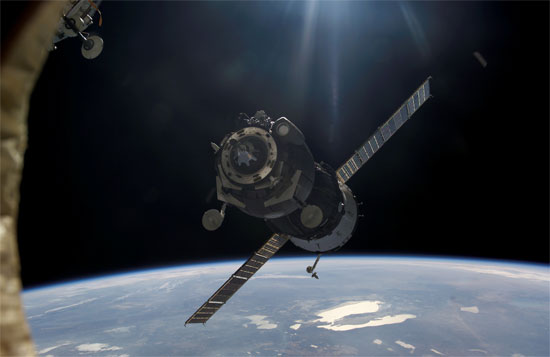Russian ships set up a feat of time to ISS
The flight to the International Space Station (ISS) on March 28 of the Soyuz spacecraft only lasted nearly 6 hours, while other flights usually took place over two days.
Chris Cassidy (USA) and Pavel Vinogradov, Alexander Misurkin (Russia) are three astronauts flying with Soyuz to ISS on March 28. The spacecraft arrived at the station at 22h28 in Eastern America, meaning only 5 hours and 45 minutes after flying up from Baikonur Cosmodrome in Kazakhstan.
To create a miracle of time, the Soyuz took off when the Baikonur space airport was closest to ISS.

Soyuz spacecraft flew to ISS on March 28. (Photo: RIA Novosti)
"Everything went according to plan," Vinogradov, Soyuz commander, informed the ground.
So far every flight to ISS, an object about 400km from the ground, takes place over a period of two days or more. This is true for both the US shuttle fleet and the Russian Soyuz squadron.
"This is a miracle , " said Kirk Shireman, deputy director of NASA's ISS program.
The Russian Federal Space Agency (Roscosmos) conducted three test flights with the Progress transport vessel before the flight of the Soyuz vessel took place. The astronauts on the Soyuz board participated in test flights.
Not only does it save time and fuel, the flight yesterday also reduces the time that astronauts must "nudge" in the tight space of the spacecraft. Thus, the risk of suffering from the effects of flying in a zero gravity environment will decrease. No gravity environment can make people feel nauseous, dizzy, or dizzy.
"When we tried to fly, in the first 4 or 5 hours we were fully awake and didn't feel any negative states , " astronaut Vinogradov told a pre-flight press conference.
The reduced flight time also means that scientific equipment and testing can reach ISS earlier, increasing the accuracy of the study.
- Russian cargo spacecraft continuously broke the flight time record
- China launched ships collecting specimens from the moon in 2017
- France-Russia will launch manned ships on Mars
- Cargo ship 'Progress M-61' successfully assembled with the ISS Station
- The naval battle caused the Russian troops to bury treasure ships of $ 133 billion
- Russia will launch ships to the moon
- Russian ships break ice to fuel Alaska
- New unmanned hi-tech ships will be built
- Video: Instructions for making ships by one-way engines
- Overseas female students
- Russian cargo ship successfully assembled with ISS
- Ships Progress M-04M successfully assembled with ISS
 Van Allen's belt and evidence that the Apollo 11 mission to the Moon was myth
Van Allen's belt and evidence that the Apollo 11 mission to the Moon was myth The levels of civilization in the universe (Kardashev scale)
The levels of civilization in the universe (Kardashev scale) Today Mars, the sun and the Earth are aligned
Today Mars, the sun and the Earth are aligned The Amazon owner announced a secret plan to build a space base for thousands of people
The Amazon owner announced a secret plan to build a space base for thousands of people